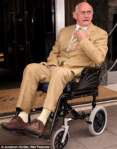In my hunger to reclaim the words I had known and loved in
my life before the stroke, my speech therapist Catherine suggested not only
should I do word search puzzles and synonyms but I should talk more aloud.
Now, most of my life has been speaking aloud, broadcasting
television and radio news, lecturing in journalism and assorted subjects, even
indulging in my secret hobby of phoning talk radio broadcasts with assumed
names and adopted accents to espouse some lame cause, or ridiculous premise.
(You may have heard me: the American who objected in a variety of put on twangs that road
rage was not a condition that was imported from America; or particular rants
against Peaches Geldof’s allegedly television presenting skills when Daddy owns
the TV production company; or Great Britain being the land of extra vowels, as
in harbour, flavour and labour).
I was comfortable expressing myself in front of people. In
fact, in classes I did for Open University academics preparing them to present
the programmes such as the OU made for the BBC, I used Mehrabian’s elements of communication rule, that words
account for 7%, tone of voice accounts for 38%, and body language accounts for
55% – that is, the tone and pitch of your voice and
body language can say more than just words which is essential in broadcasting
or your presentation would just be a script for telephone sales.
In other words: I knew about the right way of talking out
loud. But now I couldn’t. The sounds that I made were a mixture of grunts and
groans that suggested to the world I had some sort of disorder; that I had abandoned
the elements of communication; that the elements of communication had abandoned
me. Again, I hadn’t had anyone use the phrase aphasia.

Dr Seuss Enterprises 1957
There was a strange frisson of finding something to read aloud
for speech therapy when I stumbled upon The Sneetches by Dr Seuss. It was the
sheer anticipation of being able to perform and part of that is
doing my pre-performance mantra of past classes to read aloud, read aloud, read
aloud.
There are two things I should tell you about – the first is
that the Sneetches, or anything by Dr Seuss is funny but with message for
humanity – indeed the story was used to by the UN to help foster racial tolerance in Bosnia. I have remind you as I did in an earlier post that, post-stroke, I’m susceptible to laughing/crying bouts for the most trivial of feelings.
So I began preparing by reading The Sneetches aloud at home.
I was downstairs at the dining room table and opened the book:
“Now the Star-Belly Sneetches
Had bellies with stars.
The Plain-Belly Sneetches
Had none upon thars.” © Dr Seuss Enterprises 1957
Giggle.(None upon thars) SnnoorchSnnoorch. (That sound you make when you are trying squelch a laugh, but comes out anyway).
That started it. Let’s try something easier.

Dr Seuss Enterprises 1957
What was I afraid of? (That’s the Dr Seuss story and it’s appropriate) The story of a creature who
met a pair of pants with nobody inside them.
“I said, ‘I do not fear those pants
With nobody inside them.’
I said, and said and said them.
I said them. But I lied them.” © Dr Seuss Enterprises 1957
SnnoorchSnnoorch.( But I lied them) SnnoorchSnnoorch SnnoorchSnnoorch SnnoorchSnnoorch
This not going well. Or maybe too well.
I started with The Sneetches again. I read slowly, purposefully trying to get the words out but I
got one or two lines in and I’d hit a SnnoorchSnnoorch, finding it
uncontrollably funny that I (SnnoorchSnnoorch) began to get tears in my eyes. I
used the perpetual kitchen roll kept in my pocket to mop up the stray bit of
drool, to wipe the tears, now flowing freely.
And I continued until Amoret came into the room laughing and telling me it was good and stayed
because it was a good floor show.
(Better than the Edinburgh Fringe Festival. If I develop it into an act – SnnoorchSnnoorch, talking like the Swedish Chef and Tony Soprano,
added to the Stephen Hawking-esque recital of the man announcing floors in a lift/elevator, I can see The Telegraph
critic’s review of it now:
For Lou’s is one of those rare sets where you’re
never quite sure what you’re watching, or where the act starts and stops —
you’re just nervously grateful that you’re there. Lurching around like an
over-wound, damaged toy, this grimly cathartic mixture of songs, jokes, poetry
and black-hole dysfunction…
Apologies to Mark Monahan and Nick Helm)
I finished reading The Sneetches – eventually. I thought I had it out of my system, when all tears were gone, and laughter dried up, and
the nose honked dry.
I would take The Sneetches to my next session of speech therapy with Catherine.
I would read aloud.
I would impress her with my nuance of inflection, comedic timing, tone and pitch.
She would be glad at how I progressed.
When Amoret and I got there, I did my mouth exercises, did a few synonyms, opened The Sneetches and began to read.
I got maybe 10 lines into the book when:
SnnoorchSnnoorchSnnoorchSnnoorch
The Sneetches video (not me)
































